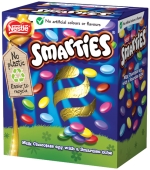
Easter is just around the corner. And for many, that means coloring hard-boiled eggs, opening up pastel-colored baskets filled with chocolates and other goodies, and (my favorite part) hunting for eggs. Unfortunately, I’m “too old” to do the egg hunt now, but there’s a new kind of egg hunt people in the packaging industry are participating in: the search for Easter eggs without excessive packaging.
Packaging an oval product in a rectangular box is bound to leave some air space in the packaging. But according to Jo Swinson, liberal democrat MP for the Scottish county of East Dunbartonshire who published her annual Easter egg packaging report, “Easter eggs provide some of the worst examples of excess packaging that can be found on supermarket shelves.”
The reportcompares 10 brands of Easter eggs and their packaging changes measured from 2007 to 2010. The last three years, Lindt held the title as the most excessively packaged Easter egg. But this year, Guylian took the spot, producing an egg that takes up only nine percent of the box.

Then there are brands that ditched the box completely and stuck with only a foil wrapper. Cadbury’s “Eco-eggs,” Lindt chocolate bunnies and Nestle’s Milkybar hollow chocolate cow are a few examples. And luckily, according to Swinson, this type of packaging is increasing.
Filled eggs would be easy enough to wrap in foil without worrying about product protection. But delicate hollow chocolates are another story. Unless they’re made unusually thick, they’ll likely need an outer box for protection. In that case, I’d encourage brands to go the Nestle route and commit to 100 percent recyclability. If you can’t reduce the amount of packaging, you can make it recyclable or even reusable.
The function of a package will always be to protect the product and appeal to consumers. But when consumers aren’t looking for excessive packaging, why not give them what they want?
